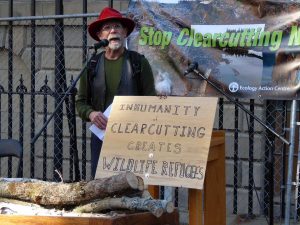One per cent old-growth forest will not maintain all the species that depend on older forests – well funded Professional Protester

Embracing Old Growth Oak in the Five Bridge Lakes Wilderness Area, Source
Soren Bondrup-Neilsen Published: 18 hours ago .
Some extracts from Healthy Forest Coalition post, Jan 12, 2019:
…But why does it make sense to drastically reduce clearcutting on Crown land? It has dire consequences for many species.
…Ecological forestry is forest management that emulates natural processes in our forests. Natural processes operating in the past meant that when Europeans colonized Nova Scotia, half of the woods were old-growth. Old-growth forests are generally not the most species-rich ecosystems, but they provide habitat to many species that depend on old forests.
The uninteresting, sometimes creepy, important species
The most critical organisms in forests are not the mammals that we tend to identify with, nor the many songbirds. Fungi, lichens, insects and a myriad of other invertebrates, which we tend to find uninteresting if not creepy, are the species that depend on, and are necessary for, the maintenance of old forest ecosystems.…Old-growth forests have been reduced to less than one per cent and are becoming an endangered ecosystem. The Department of Lands and Forestry argues that we have species-at-risk legislation and forest management decisions take this legislation into account.
However, for species to be listed under this legislation, we have to know they exist and we have to have data to show that they are endangered. But we have no data for the vast majority of species other than for so-called charismatic ones like lynx, boreal felt lichen, mainland moose and a few others that have been listed as species at risk.…One per cent old-growth forest will not maintain all the species that depend on older forests. Old forests on Crown land, selectively cut for value-added industries, could maintain habitat for most species, all the while providing meaningful jobs”.
Soren Bondrup-Neilsen is Professor Emeritus, Department of Biology Acadia University Wolfville.
Soren at the Forest Funeral
 A lament to Forest Wildlife – Dr. Soren Bondrup-Nielsen, Professor of Biology, Acadia University A lament to Forest Wildlife – Dr. Soren Bondrup-Nielsen, Professor of Biology, Acadia University
The inhumanity of clearcutting is that it creates wildlife refugees…
|
A Professional Protester or a Professional who is Protesting?
“The press/media basically covers one side of the issues, most politicians just say what they think they need to get re-elected, and the people voicing most of the anti-forest industry rhetoric are more or less professional protestors. The latter group is a very small percentage of the total population, but a very vocal group, that are experts at navigating the various media in the province and rallying other groups to support their cause. They hide under the guise of environmentalists when in fact most of these groups have their own personal agendas, and most of these people seem to be very well funded to do what they do.” – Peter Spicer
I guess only Forest Industry folks are objective and are not well funded, so SB-N must be a well funded Professional Protester like all of the other speakers at the Forest Funeral. I mean why would a Professional Person go so public when backroom dealing is more effective? ‘Must be a fake PhD.
